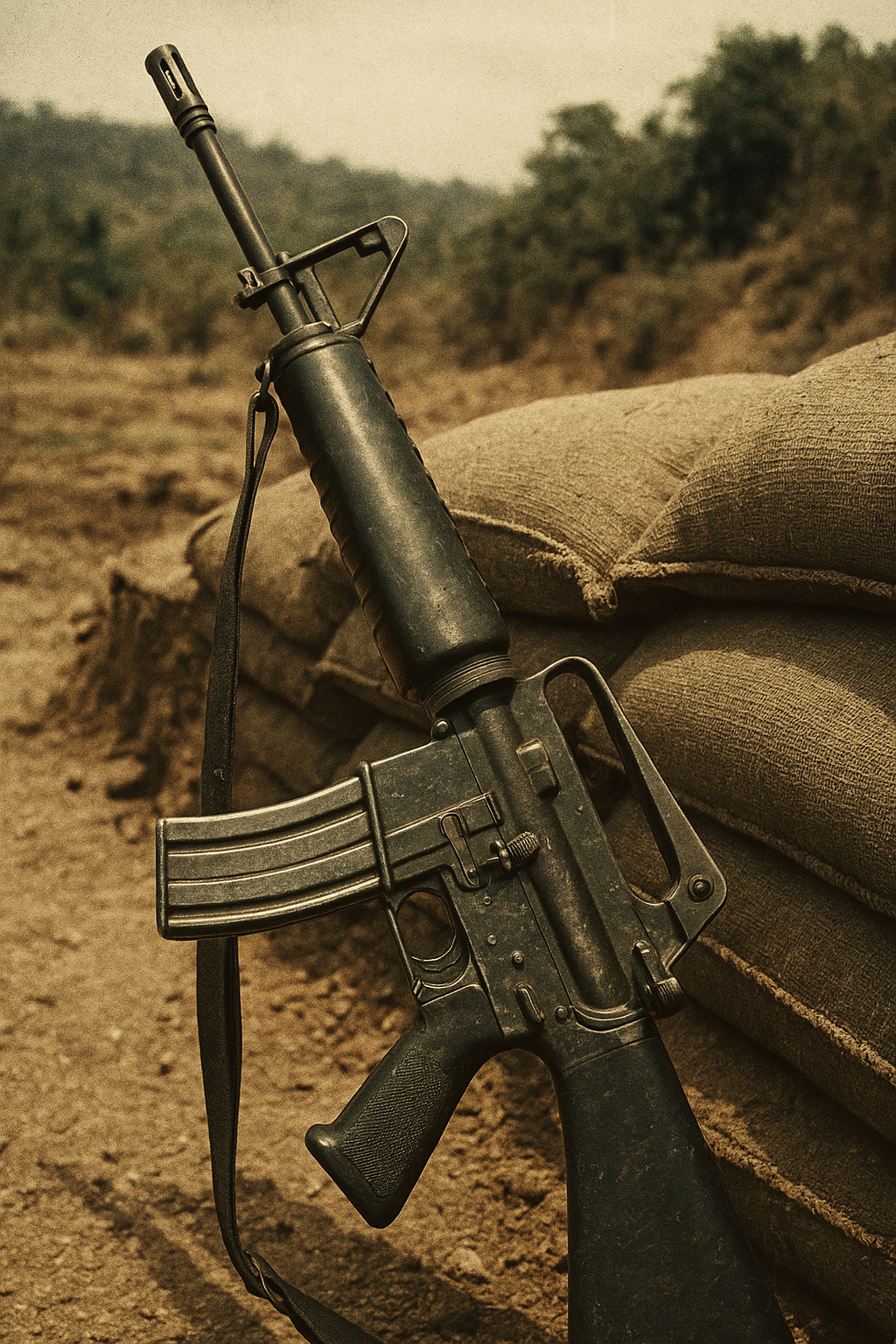From Vietnam to the Civilian Market: The History of the M16 and AR-15
Few firearms in modern history have generated as much controversy, admiration, and influence as the M16 and its civilian counterpart, the AR-15. From the jungles of Vietnam to suburban gun safes, these rifles have defined military and civilian shooting for over half a century.-Rafael Benavente

By Rafael Benavente
Few firearms in modern history have generated as much controversy, admiration, and influence as the M16 and its civilian counterpart, the AR-15. From the jungles of Vietnam to suburban gun safes, these rifles have defined military and civilian shooting for over half a century.
But how did the M16 become the U.S. military’s standard rifle? And how did the AR-15 evolve into the most popular sporting rifle in America?
Let’s explore the intertwined histories of these iconic firearms — from their innovation and battlefield challenges to the political spotlight they occupy today.
🔧 The Birth of a New Rifle: Enter Eugene Stoner
The story begins in the 1950s with Eugene Stoner, the chief engineer at Armalite, a division of Fairchild Aircraft Corporation. Tasked with creating a lightweight combat rifle for modern warfare, Stoner developed the AR-10 — a revolutionary rifle using aircraft-grade aluminum and fiberglass.
Although the AR-10 didn’t win major military contracts, its design inspired a smaller-caliber version: the AR-15, chambered in .223 Remington.
In 1959, Armalite sold the AR-15’s rights to Colt Firearms, which began marketing it to military forces around the world.
🎖️ Vietnam War and the Rise of the M16
In the early 1960s, the U.S. military was searching for a new infantry rifle. The M14, which had replaced the M1 Garand, was heavy, hard-kicking, and struggled in jungle environments. After field testing, the AR-15 impressed with its low recoil, lightweight design, and high rate of fire.
In 1964, the U.S. Air Force became the first branch to adopt the rifle, calling it the M16. Soon after, the Army and Marines followed — and the M16 saw its first major combat use in the Vietnam War.
⚠️ Early Problems in Vietnam
Unfortunately, the early M16 rifles were plagued with issues:
- Lack of chrome lining in barrels (prone to corrosion)
- Soldiers weren’t issued cleaning kits
- Ammunition powder was changed without adjusting the rifle’s gas system
The result? Catastrophic failures and deadly malfunctions in combat.
Troops complained that the M16 jammed frequently — especially in the humid jungle. The phrase "You die if your rifle jams" became a grim reality.
Congress investigated, and the military corrected the issues:
- Chrome-lined barrels
- Improved powder
- Training on proper maintenance
- Introduction of the M16A1 in 1967
Despite the rocky start, the M16 eventually earned a place as the standard U.S. service rifle.
📈 Evolution of the M16
The M16 platform has gone through numerous upgrades over the decades:
| Model | Notable Features |
|---|---|
| M16A1 | Chrome-lined bore, forward assist |
| M16A2 | 3-round burst, improved barrel twist for heavier rounds |
| M16A3 | Fully automatic, similar to A1 with A2 upgrades |
| M16A4 | Picatinny rail system for optics and accessories |
Eventually, the M4 Carbine — a shortened and updated version of the M16 — became the standard infantry weapon by the 2000s, especially for close-quarters combat in Iraq and Afghanistan.
🏠 The Civilian Side: The AR-15
While the M16 evolved in the military, Colt continued producing a semi-automatic version for civilian use: the AR-15 Sporter.
Despite popular belief, “AR” does not stand for “Assault Rifle” — it stands for Armalite Rifle.
The civilian AR-15:
- Fires one round per trigger pull (semi-auto only)
- Comes in a variety of calibers (.223/5.56 most common)
- Is highly modular — users can change barrels, triggers, handguards, stocks, and optics with ease
The 1994 Federal Assault Weapons Ban (which lasted until 2004) temporarily halted the production of many AR-15-style rifles with certain features, but the ban’s expiration triggered a surge in popularity.
📊 The Most Popular Rifle in America
By the 2010s, the AR-15 had become the most popular rifle platform in the United States — embraced by:
- Competitive shooters
- Hunters
- Law enforcement
- Gun enthusiasts
- Preppers and home defenders
Its modular design, low recoil, and availability of parts made it the “Lego set” of firearms.
🔥 Controversy and Cultural Divide
The AR-15’s popularity has also made it a lightning rod in political debates, especially following mass shootings where variants of the AR platform were used.
Critics argue the rifle is too dangerous for civilian use, often labeling it a “weapon of war.” Supporters counter that:
- It is functionally no different from many other semi-auto rifles
- The vast majority of AR-15s are owned responsibly
- Bans focus on cosmetic features rather than function
The debate has led to proposed bans, lawsuits, and state-level restrictions — particularly in places like California, New York, and New Jersey.
🔍 M16 vs AR-15: Key Differences
| Feature | M16 | AR-15 |
|---|---|---|
| Fire Mode | Select fire (auto/burst) | Semi-auto only |
| Used By | Military | Civilians, law enforcement |
| Regulated By | Federal gov't (NFA) | ATF (standard FFL purchase) |
| Legal to Own? | No (without special NFA) | Yes (in most U.S. states) |
| Customization | Limited (mil-spec) | High (aftermarket supported) |
🧠 Cultural Icon or Political Scapegoat?
The M16 and AR-15 have been:
- Featured in countless films, games, and documentaries
- Celebrated by veterans who carried them
- Vilified by politicians seeking stricter gun control
They are simultaneously symbols of American freedom and flashpoints in the nation’s ongoing gun debate.
🛠️ The Future of the Platform
Despite pressure from legislators, the AR-15 platform is here to stay. Manufacturers continue to innovate with:
- Carbon fiber barrels
- Billet aluminum receivers
- Caliber conversions (.300 Blackout, 6.5 Grendel, etc.)
- Integrations with suppressors and digital optics
Military forces worldwide, while moving toward next-generation rifles, still rely on derivatives of the M16/AR-15 system — a testament to its brilliant, adaptable design.
🇺🇸 Final Thoughts
Whether you view it as a defensive tool, a sporting rifle, or a controversial symbol, the M16/AR-15 platform has reshaped modern warfare and civilian firearms ownership alike.
It was born in innovation, tested in war, refined through decades, and is now part of American identity — for better or worse.
By Rafael Benavente
take a look at another related article here.
